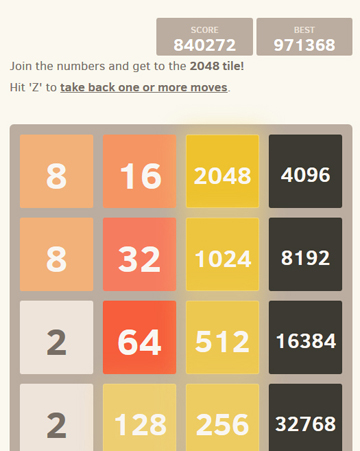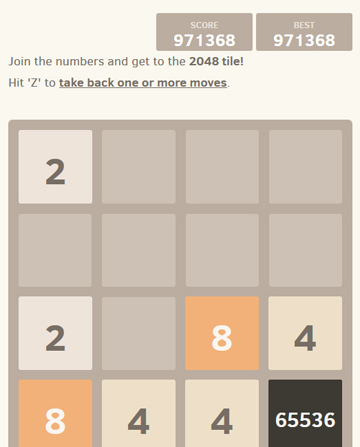I recently became addicted to an intelligent computer game called 2048. The idea is to merge tiles of equal values, such as 4 with 4 to get 8, until you reach 2048. A new tile, usually 2, but sometimes 4, appears in a more or less random position with each move. One tries to merge the tiles without allowing the 4x4 board to clog up, which means the end of the game.
After some weeks of effort I became reasonably proficient and was able to reach the 2048 tile repeatedly, though not reliably. I was frustrated because I'd make good progress until a careless slip or bad luck ruined my chances of winning. While 2048 is the stated aim, the real challenge is to reach the 4096 tile, or higher.
I finally made the switch to 2048undo. This version of the game allows you to undo multiple moves by hitting 'z'. This removes the frustration factor and allows far more progress. The best I ever managed in the original game was to reach 4096 on two occasions, out of hundreds of attempts. I strongly recommend playing the undo version of 2048 because it is a lot more fun, far less frustrating and you will get much further. Also, you will learn more quickly the patterns that arise and how to use them.
Playing 2048undo, I got much further. My best effort took about three days, with many seemingly insurmountable blocks along the way, which almost made me give up more than once. After overcoming some agonizing blocks, I reached the 65536 tile. The screen shot below shows the sweet moment just before I combined all the numbers shown (except the 2s) into the 65536 tile.

My strategy playing 2048 is to create a row containing an ascending sequence, such as 64 32 16 8, and then steadily increase the values in the row, always in ascending order. The row should be at an outer edge. Once you establish this, you will only move the numbers in one of three directions until the end of the game.
Liberal use of the undo function corrects any mistakes or instances of bad luck, such as getting 2 64 32 16 after shifting 64 32 16 to the right. The image at right shows how the ascending sequence snakes around multiple columns, as it needs to at times.
It is a good idea not to allow tiles 32 or larger to form outside of the ascending sequence, as they often block progress. Another pitfall is getting a 2 with higher numbers all around it, which can be hard to fix. A third problem is getting two or three full rows with no possibility to move except in the forbidden direction, which messes things up badly. These and other difficulties make the undo feature a godsend.
Sometimes, I get a long way and reach a dead-end, requiring extensive use of the undo. On the other hand, it also happens that I get to what looks like a hopeless position, only to find that everything suddenly comes good.
The game gets harder as you form more high-value tiles for two reasons. Firstly, the high-value tiles are fixed and hence you have less space to play with. Secondly, you have to form higher value than before tiles to make progress at the low end of the chain.
I'm not sure what the maximum reachable tile is. Probably 131072, but I am disinclined to put in the immense effort to try to get that far. However, I recommend this enjoyable and intelligent game. Be warned, it is addictive!
Shown below is the screen after I made the 65536 tile. After this, I played on till I passed a million points and then retired from the game. Have fun!
